BUS707 - Analyzing Auditor Rotation's Impact on Auditor Performance
VerifiedAdded on 2023/06/11
|24
|6288
|457
Report
AI Summary
This report investigates the impact of auditor rotation on auditor performance, focusing on Australian Stock Exchange-listed companies. It addresses the research problem of properly identifying the current scenario of auditors in Australia and the concept of auditor independence. The research objectives include analyzing the relationship between auditor performance and auditor rotation, and determining the advantages of auditor independence for companies. The literature review discusses both the positive and negative implications of auditor rotation, highlighting its potential to improve audit quality and independence while also acknowledging potential disruptions and costs. The methodology section details the research type, approach, data type, collection methods, sampling, and data analysis techniques employed to achieve constructive findings, along with ethical considerations. This document is available on Desklib, a platform offering a wide range of study tools and solved assignments for students.
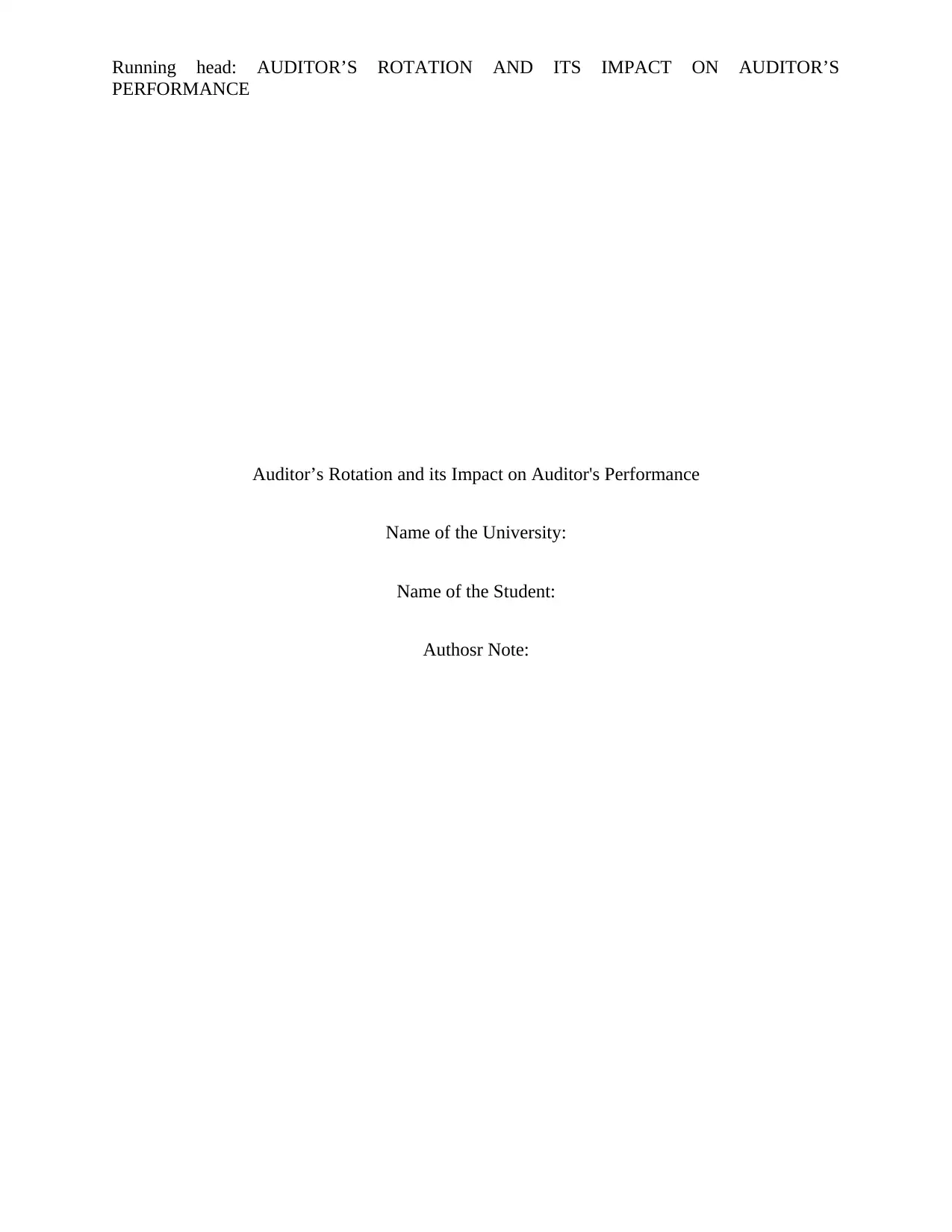
Running head: AUDITOR’S ROTATION AND ITS IMPACT ON AUDITOR’S
PERFORMANCE
Auditor’s Rotation and its Impact on Auditor's Performance
Name of the University:
Name of the Student:
Authosr Note:
PERFORMANCE
Auditor’s Rotation and its Impact on Auditor's Performance
Name of the University:
Name of the Student:
Authosr Note:
Paraphrase This Document
Need a fresh take? Get an instant paraphrase of this document with our AI Paraphraser
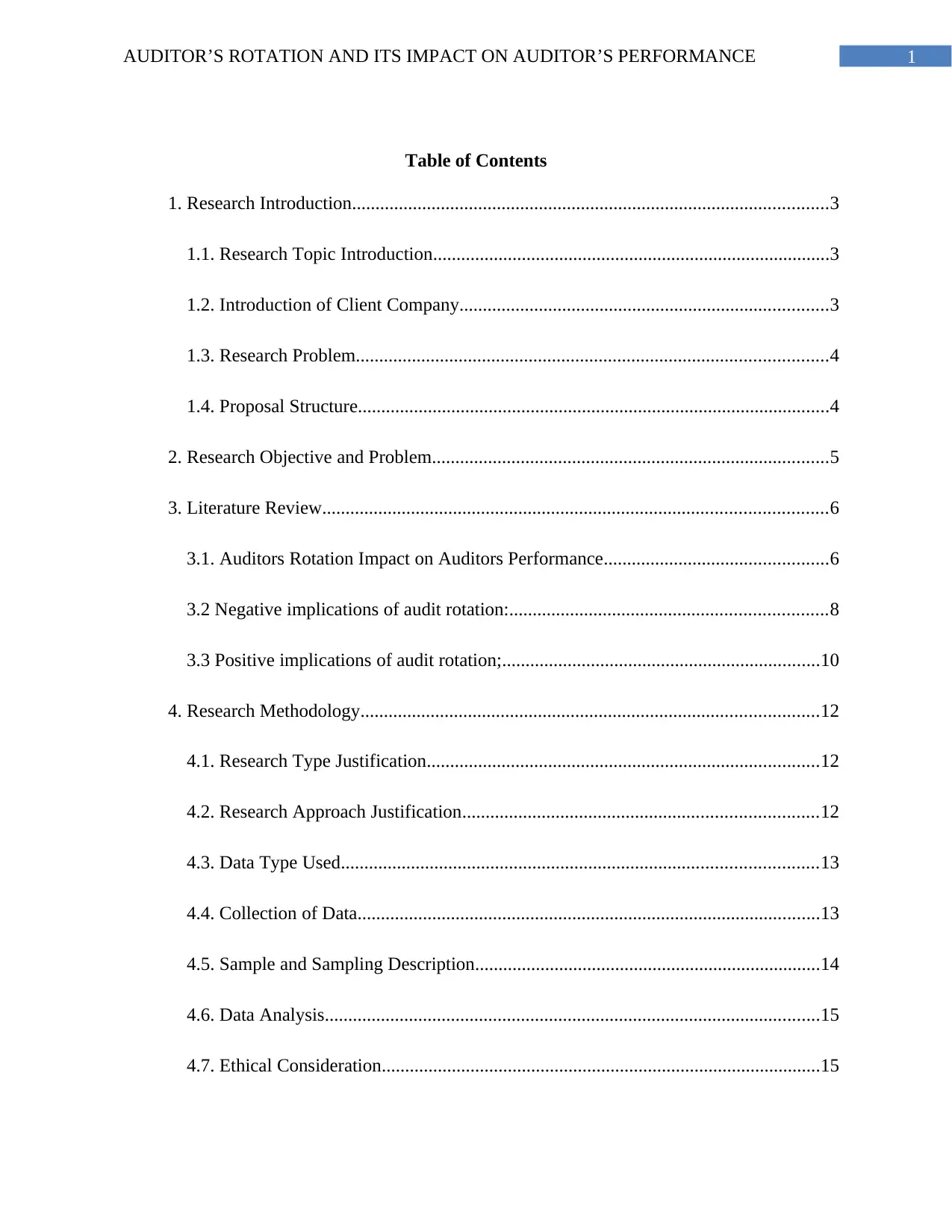
1AUDITOR’S ROTATION AND ITS IMPACT ON AUDITOR’S PERFORMANCE
Table of Contents
1. Research Introduction......................................................................................................3
1.1. Research Topic Introduction.....................................................................................3
1.2. Introduction of Client Company...............................................................................3
1.3. Research Problem.....................................................................................................4
1.4. Proposal Structure.....................................................................................................4
2. Research Objective and Problem.....................................................................................5
3. Literature Review............................................................................................................6
3.1. Auditors Rotation Impact on Auditors Performance................................................6
3.2 Negative implications of audit rotation:....................................................................8
3.3 Positive implications of audit rotation;....................................................................10
4. Research Methodology..................................................................................................12
4.1. Research Type Justification....................................................................................12
4.2. Research Approach Justification............................................................................12
4.3. Data Type Used......................................................................................................13
4.4. Collection of Data...................................................................................................13
4.5. Sample and Sampling Description..........................................................................14
4.6. Data Analysis..........................................................................................................15
4.7. Ethical Consideration..............................................................................................15
Table of Contents
1. Research Introduction......................................................................................................3
1.1. Research Topic Introduction.....................................................................................3
1.2. Introduction of Client Company...............................................................................3
1.3. Research Problem.....................................................................................................4
1.4. Proposal Structure.....................................................................................................4
2. Research Objective and Problem.....................................................................................5
3. Literature Review............................................................................................................6
3.1. Auditors Rotation Impact on Auditors Performance................................................6
3.2 Negative implications of audit rotation:....................................................................8
3.3 Positive implications of audit rotation;....................................................................10
4. Research Methodology..................................................................................................12
4.1. Research Type Justification....................................................................................12
4.2. Research Approach Justification............................................................................12
4.3. Data Type Used......................................................................................................13
4.4. Collection of Data...................................................................................................13
4.5. Sample and Sampling Description..........................................................................14
4.6. Data Analysis..........................................................................................................15
4.7. Ethical Consideration..............................................................................................15
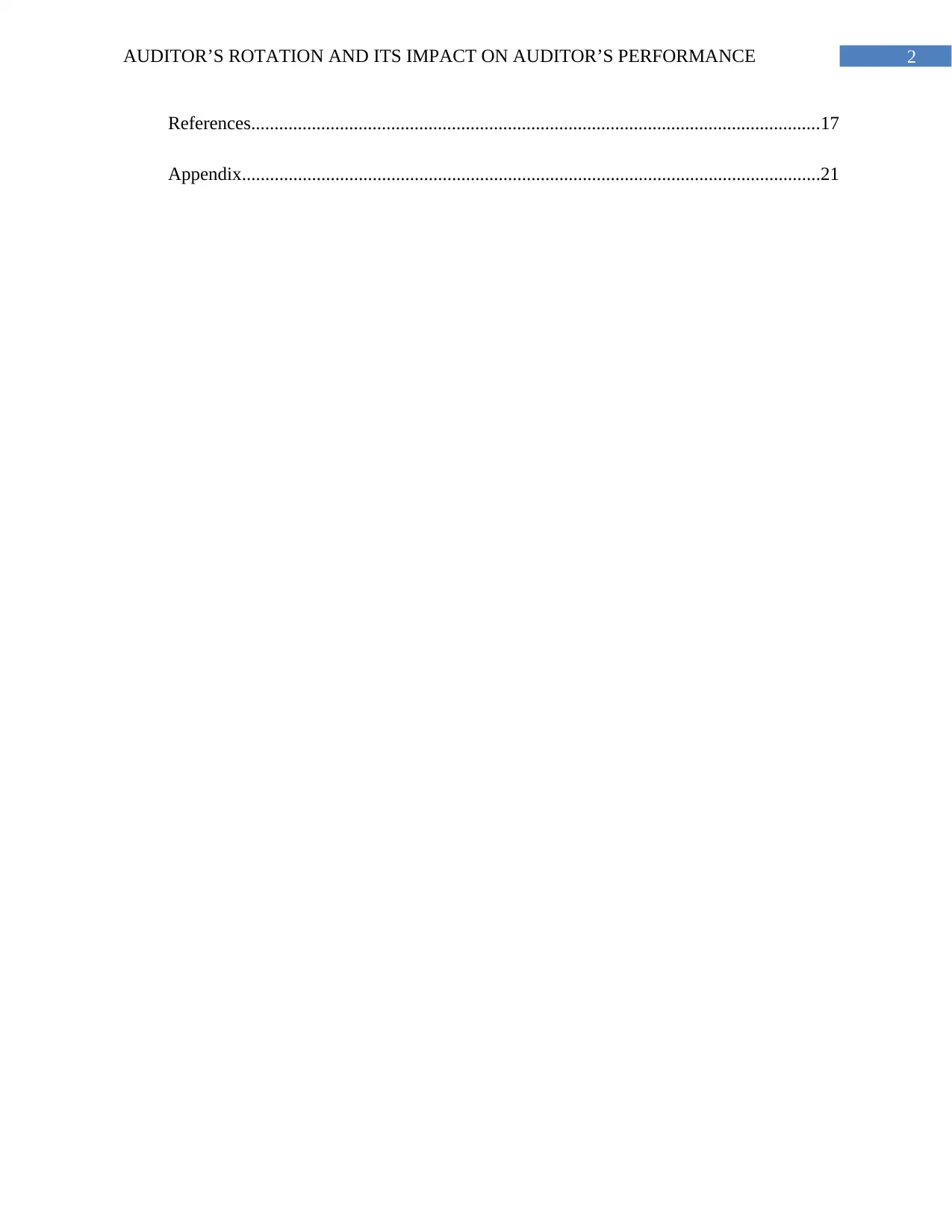
2AUDITOR’S ROTATION AND ITS IMPACT ON AUDITOR’S PERFORMANCE
References..........................................................................................................................17
Appendix............................................................................................................................21
References..........................................................................................................................17
Appendix............................................................................................................................21
⊘ This is a preview!⊘
Do you want full access?
Subscribe today to unlock all pages.

Trusted by 1+ million students worldwide
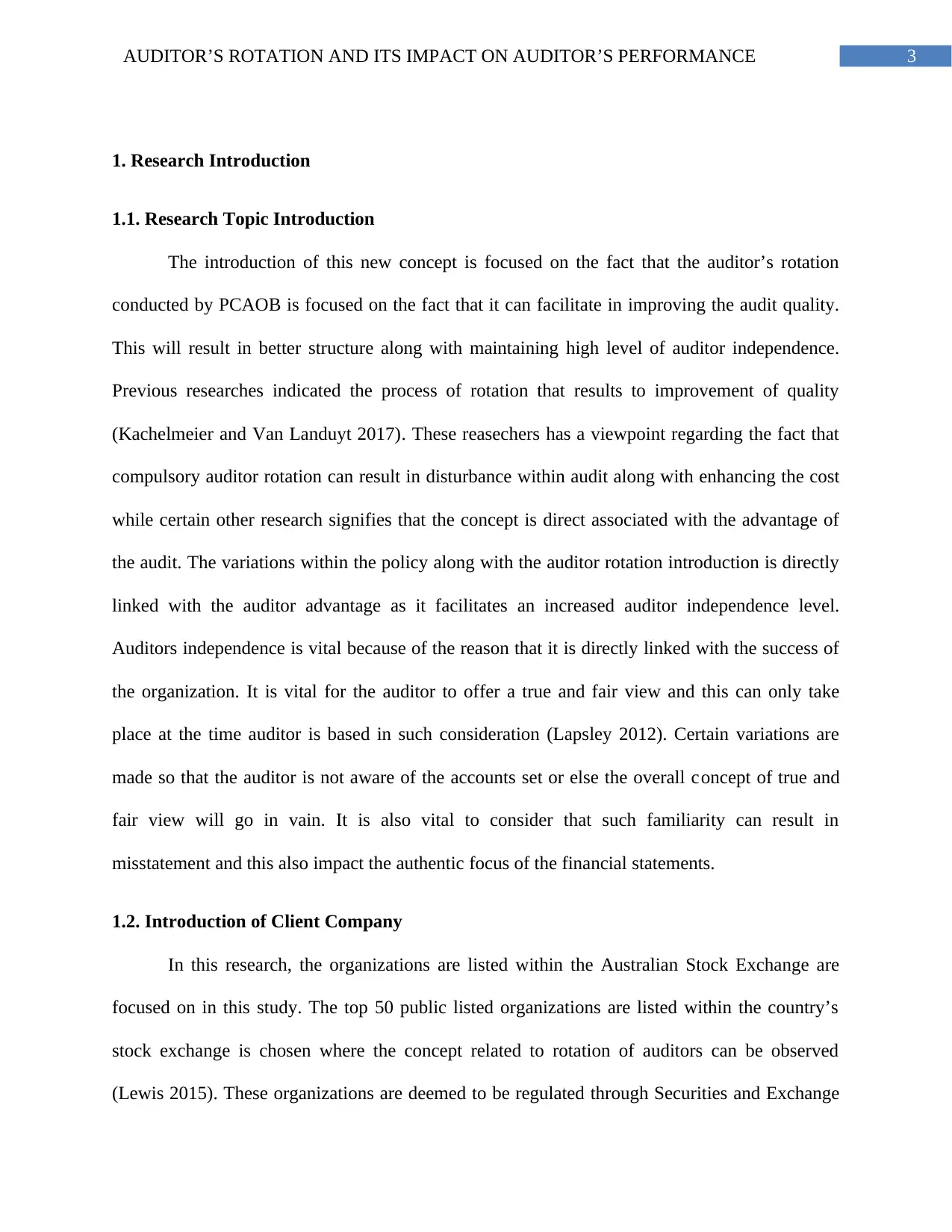
3AUDITOR’S ROTATION AND ITS IMPACT ON AUDITOR’S PERFORMANCE
1. Research Introduction
1.1. Research Topic Introduction
The introduction of this new concept is focused on the fact that the auditor’s rotation
conducted by PCAOB is focused on the fact that it can facilitate in improving the audit quality.
This will result in better structure along with maintaining high level of auditor independence.
Previous researches indicated the process of rotation that results to improvement of quality
(Kachelmeier and Van Landuyt 2017). These reasechers has a viewpoint regarding the fact that
compulsory auditor rotation can result in disturbance within audit along with enhancing the cost
while certain other research signifies that the concept is direct associated with the advantage of
the audit. The variations within the policy along with the auditor rotation introduction is directly
linked with the auditor advantage as it facilitates an increased auditor independence level.
Auditors independence is vital because of the reason that it is directly linked with the success of
the organization. It is vital for the auditor to offer a true and fair view and this can only take
place at the time auditor is based in such consideration (Lapsley 2012). Certain variations are
made so that the auditor is not aware of the accounts set or else the overall concept of true and
fair view will go in vain. It is also vital to consider that such familiarity can result in
misstatement and this also impact the authentic focus of the financial statements.
1.2. Introduction of Client Company
In this research, the organizations are listed within the Australian Stock Exchange are
focused on in this study. The top 50 public listed organizations are listed within the country’s
stock exchange is chosen where the concept related to rotation of auditors can be observed
(Lewis 2015). These organizations are deemed to be regulated through Securities and Exchange
1. Research Introduction
1.1. Research Topic Introduction
The introduction of this new concept is focused on the fact that the auditor’s rotation
conducted by PCAOB is focused on the fact that it can facilitate in improving the audit quality.
This will result in better structure along with maintaining high level of auditor independence.
Previous researches indicated the process of rotation that results to improvement of quality
(Kachelmeier and Van Landuyt 2017). These reasechers has a viewpoint regarding the fact that
compulsory auditor rotation can result in disturbance within audit along with enhancing the cost
while certain other research signifies that the concept is direct associated with the advantage of
the audit. The variations within the policy along with the auditor rotation introduction is directly
linked with the auditor advantage as it facilitates an increased auditor independence level.
Auditors independence is vital because of the reason that it is directly linked with the success of
the organization. It is vital for the auditor to offer a true and fair view and this can only take
place at the time auditor is based in such consideration (Lapsley 2012). Certain variations are
made so that the auditor is not aware of the accounts set or else the overall concept of true and
fair view will go in vain. It is also vital to consider that such familiarity can result in
misstatement and this also impact the authentic focus of the financial statements.
1.2. Introduction of Client Company
In this research, the organizations are listed within the Australian Stock Exchange are
focused on in this study. The top 50 public listed organizations are listed within the country’s
stock exchange is chosen where the concept related to rotation of auditors can be observed
(Lewis 2015). These organizations are deemed to be regulated through Securities and Exchange
Paraphrase This Document
Need a fresh take? Get an instant paraphrase of this document with our AI Paraphraser
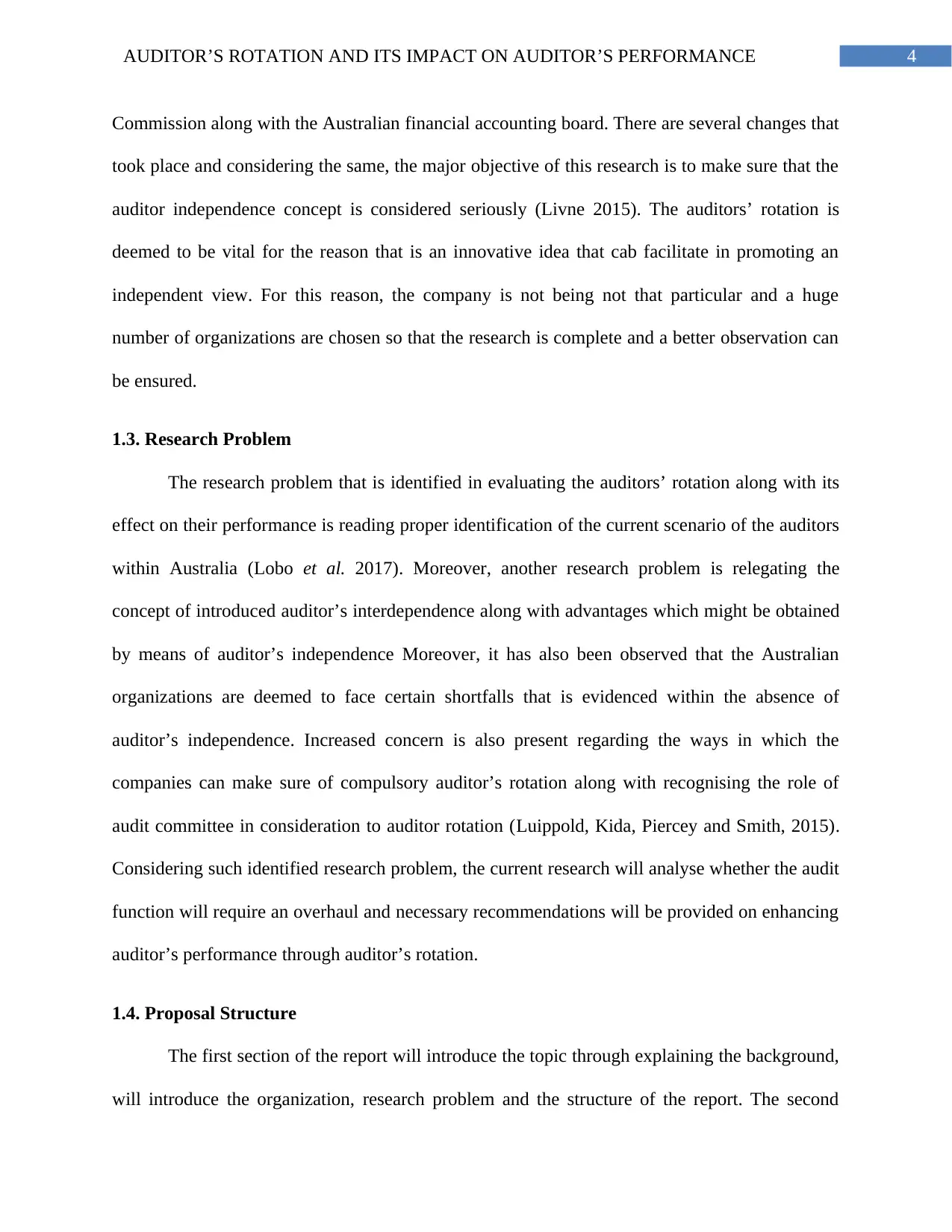
4AUDITOR’S ROTATION AND ITS IMPACT ON AUDITOR’S PERFORMANCE
Commission along with the Australian financial accounting board. There are several changes that
took place and considering the same, the major objective of this research is to make sure that the
auditor independence concept is considered seriously (Livne 2015). The auditors’ rotation is
deemed to be vital for the reason that is an innovative idea that cab facilitate in promoting an
independent view. For this reason, the company is not being not that particular and a huge
number of organizations are chosen so that the research is complete and a better observation can
be ensured.
1.3. Research Problem
The research problem that is identified in evaluating the auditors’ rotation along with its
effect on their performance is reading proper identification of the current scenario of the auditors
within Australia (Lobo et al. 2017). Moreover, another research problem is relegating the
concept of introduced auditor’s interdependence along with advantages which might be obtained
by means of auditor’s independence Moreover, it has also been observed that the Australian
organizations are deemed to face certain shortfalls that is evidenced within the absence of
auditor’s independence. Increased concern is also present regarding the ways in which the
companies can make sure of compulsory auditor’s rotation along with recognising the role of
audit committee in consideration to auditor rotation (Luippold, Kida, Piercey and Smith, 2015).
Considering such identified research problem, the current research will analyse whether the audit
function will require an overhaul and necessary recommendations will be provided on enhancing
auditor’s performance through auditor’s rotation.
1.4. Proposal Structure
The first section of the report will introduce the topic through explaining the background,
will introduce the organization, research problem and the structure of the report. The second
Commission along with the Australian financial accounting board. There are several changes that
took place and considering the same, the major objective of this research is to make sure that the
auditor independence concept is considered seriously (Livne 2015). The auditors’ rotation is
deemed to be vital for the reason that is an innovative idea that cab facilitate in promoting an
independent view. For this reason, the company is not being not that particular and a huge
number of organizations are chosen so that the research is complete and a better observation can
be ensured.
1.3. Research Problem
The research problem that is identified in evaluating the auditors’ rotation along with its
effect on their performance is reading proper identification of the current scenario of the auditors
within Australia (Lobo et al. 2017). Moreover, another research problem is relegating the
concept of introduced auditor’s interdependence along with advantages which might be obtained
by means of auditor’s independence Moreover, it has also been observed that the Australian
organizations are deemed to face certain shortfalls that is evidenced within the absence of
auditor’s independence. Increased concern is also present regarding the ways in which the
companies can make sure of compulsory auditor’s rotation along with recognising the role of
audit committee in consideration to auditor rotation (Luippold, Kida, Piercey and Smith, 2015).
Considering such identified research problem, the current research will analyse whether the audit
function will require an overhaul and necessary recommendations will be provided on enhancing
auditor’s performance through auditor’s rotation.
1.4. Proposal Structure
The first section of the report will introduce the topic through explaining the background,
will introduce the organization, research problem and the structure of the report. The second
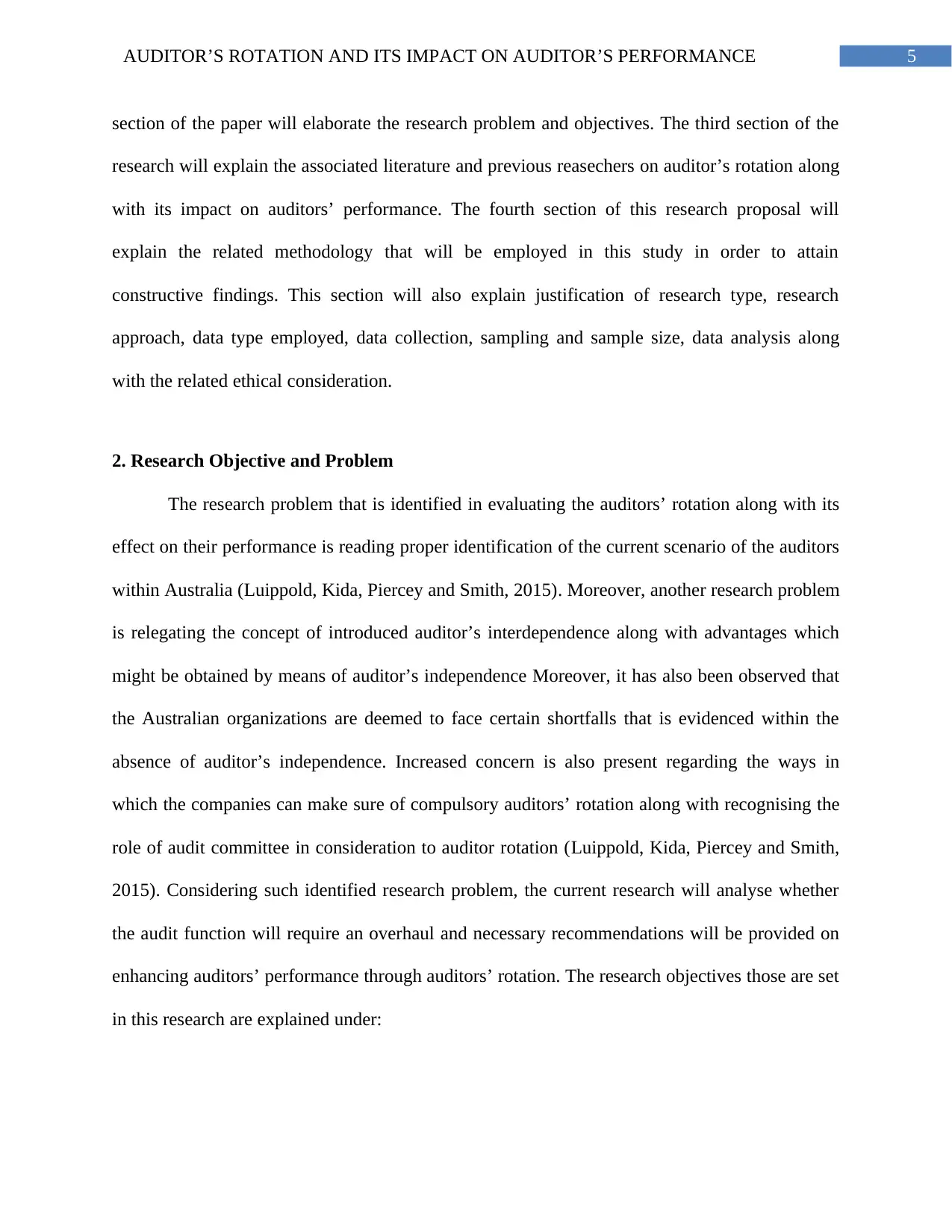
5AUDITOR’S ROTATION AND ITS IMPACT ON AUDITOR’S PERFORMANCE
section of the paper will elaborate the research problem and objectives. The third section of the
research will explain the associated literature and previous reasechers on auditor’s rotation along
with its impact on auditors’ performance. The fourth section of this research proposal will
explain the related methodology that will be employed in this study in order to attain
constructive findings. This section will also explain justification of research type, research
approach, data type employed, data collection, sampling and sample size, data analysis along
with the related ethical consideration.
2. Research Objective and Problem
The research problem that is identified in evaluating the auditors’ rotation along with its
effect on their performance is reading proper identification of the current scenario of the auditors
within Australia (Luippold, Kida, Piercey and Smith, 2015). Moreover, another research problem
is relegating the concept of introduced auditor’s interdependence along with advantages which
might be obtained by means of auditor’s independence Moreover, it has also been observed that
the Australian organizations are deemed to face certain shortfalls that is evidenced within the
absence of auditor’s independence. Increased concern is also present regarding the ways in
which the companies can make sure of compulsory auditors’ rotation along with recognising the
role of audit committee in consideration to auditor rotation (Luippold, Kida, Piercey and Smith,
2015). Considering such identified research problem, the current research will analyse whether
the audit function will require an overhaul and necessary recommendations will be provided on
enhancing auditors’ performance through auditors’ rotation. The research objectives those are set
in this research are explained under:
section of the paper will elaborate the research problem and objectives. The third section of the
research will explain the associated literature and previous reasechers on auditor’s rotation along
with its impact on auditors’ performance. The fourth section of this research proposal will
explain the related methodology that will be employed in this study in order to attain
constructive findings. This section will also explain justification of research type, research
approach, data type employed, data collection, sampling and sample size, data analysis along
with the related ethical consideration.
2. Research Objective and Problem
The research problem that is identified in evaluating the auditors’ rotation along with its
effect on their performance is reading proper identification of the current scenario of the auditors
within Australia (Luippold, Kida, Piercey and Smith, 2015). Moreover, another research problem
is relegating the concept of introduced auditor’s interdependence along with advantages which
might be obtained by means of auditor’s independence Moreover, it has also been observed that
the Australian organizations are deemed to face certain shortfalls that is evidenced within the
absence of auditor’s independence. Increased concern is also present regarding the ways in
which the companies can make sure of compulsory auditors’ rotation along with recognising the
role of audit committee in consideration to auditor rotation (Luippold, Kida, Piercey and Smith,
2015). Considering such identified research problem, the current research will analyse whether
the audit function will require an overhaul and necessary recommendations will be provided on
enhancing auditors’ performance through auditors’ rotation. The research objectives those are set
in this research are explained under:
⊘ This is a preview!⊘
Do you want full access?
Subscribe today to unlock all pages.

Trusted by 1+ million students worldwide
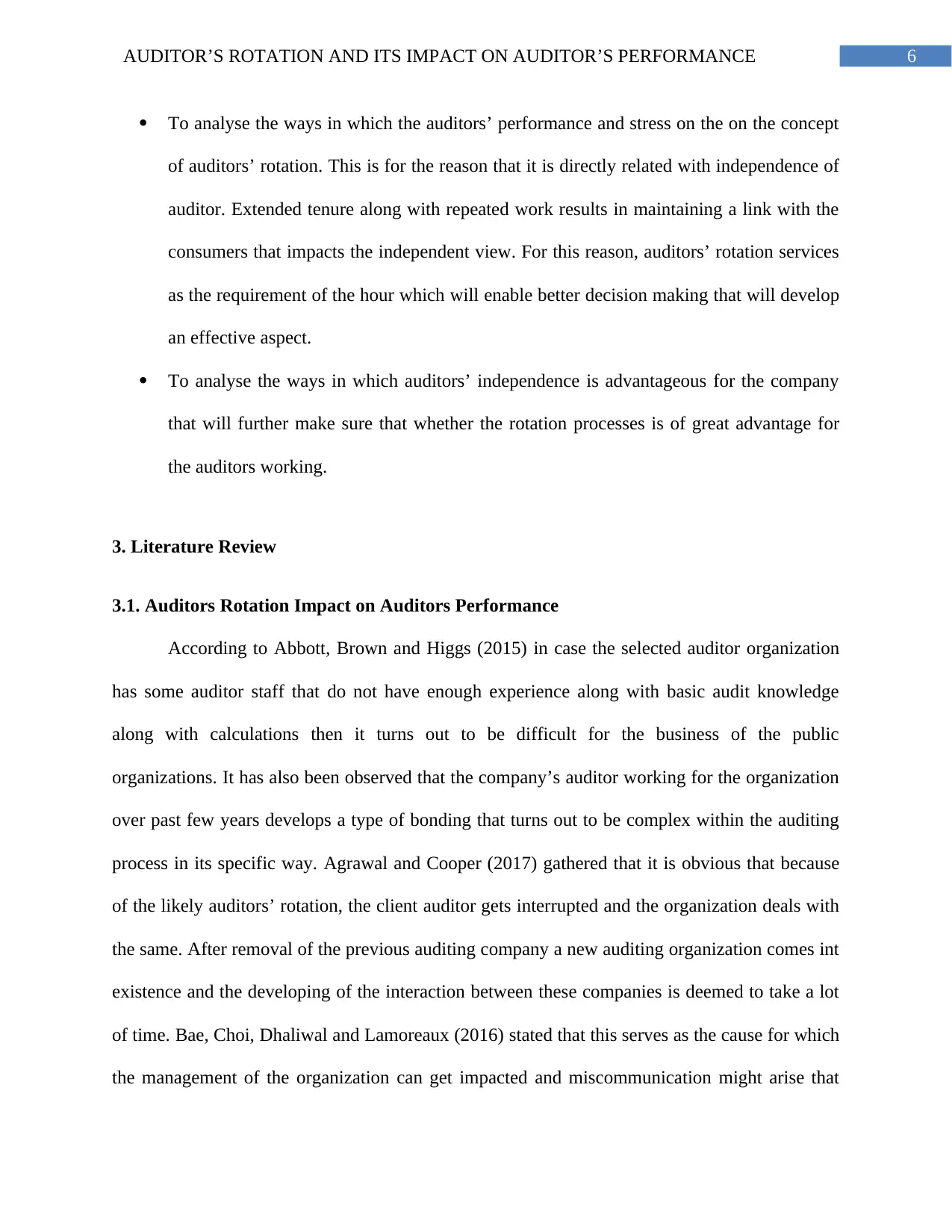
6AUDITOR’S ROTATION AND ITS IMPACT ON AUDITOR’S PERFORMANCE
To analyse the ways in which the auditors’ performance and stress on the on the concept
of auditors’ rotation. This is for the reason that it is directly related with independence of
auditor. Extended tenure along with repeated work results in maintaining a link with the
consumers that impacts the independent view. For this reason, auditors’ rotation services
as the requirement of the hour which will enable better decision making that will develop
an effective aspect.
To analyse the ways in which auditors’ independence is advantageous for the company
that will further make sure that whether the rotation processes is of great advantage for
the auditors working.
3. Literature Review
3.1. Auditors Rotation Impact on Auditors Performance
According to Abbott, Brown and Higgs (2015) in case the selected auditor organization
has some auditor staff that do not have enough experience along with basic audit knowledge
along with calculations then it turns out to be difficult for the business of the public
organizations. It has also been observed that the company’s auditor working for the organization
over past few years develops a type of bonding that turns out to be complex within the auditing
process in its specific way. Agrawal and Cooper (2017) gathered that it is obvious that because
of the likely auditors’ rotation, the client auditor gets interrupted and the organization deals with
the same. After removal of the previous auditing company a new auditing organization comes int
existence and the developing of the interaction between these companies is deemed to take a lot
of time. Bae, Choi, Dhaliwal and Lamoreaux (2016) stated that this serves as the cause for which
the management of the organization can get impacted and miscommunication might arise that
To analyse the ways in which the auditors’ performance and stress on the on the concept
of auditors’ rotation. This is for the reason that it is directly related with independence of
auditor. Extended tenure along with repeated work results in maintaining a link with the
consumers that impacts the independent view. For this reason, auditors’ rotation services
as the requirement of the hour which will enable better decision making that will develop
an effective aspect.
To analyse the ways in which auditors’ independence is advantageous for the company
that will further make sure that whether the rotation processes is of great advantage for
the auditors working.
3. Literature Review
3.1. Auditors Rotation Impact on Auditors Performance
According to Abbott, Brown and Higgs (2015) in case the selected auditor organization
has some auditor staff that do not have enough experience along with basic audit knowledge
along with calculations then it turns out to be difficult for the business of the public
organizations. It has also been observed that the company’s auditor working for the organization
over past few years develops a type of bonding that turns out to be complex within the auditing
process in its specific way. Agrawal and Cooper (2017) gathered that it is obvious that because
of the likely auditors’ rotation, the client auditor gets interrupted and the organization deals with
the same. After removal of the previous auditing company a new auditing organization comes int
existence and the developing of the interaction between these companies is deemed to take a lot
of time. Bae, Choi, Dhaliwal and Lamoreaux (2016) stated that this serves as the cause for which
the management of the organization can get impacted and miscommunication might arise that
Paraphrase This Document
Need a fresh take? Get an instant paraphrase of this document with our AI Paraphraser
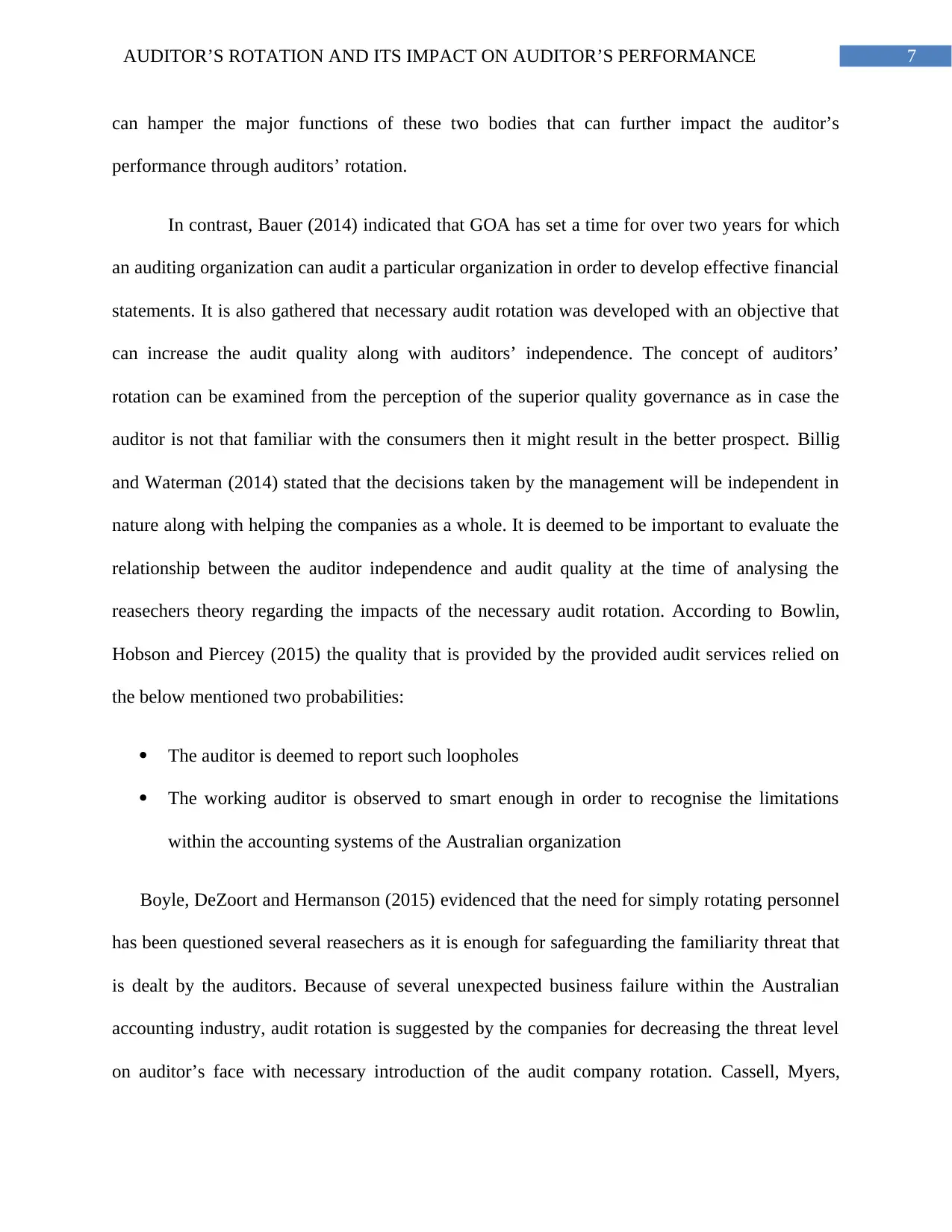
7AUDITOR’S ROTATION AND ITS IMPACT ON AUDITOR’S PERFORMANCE
can hamper the major functions of these two bodies that can further impact the auditor’s
performance through auditors’ rotation.
In contrast, Bauer (2014) indicated that GOA has set a time for over two years for which
an auditing organization can audit a particular organization in order to develop effective financial
statements. It is also gathered that necessary audit rotation was developed with an objective that
can increase the audit quality along with auditors’ independence. The concept of auditors’
rotation can be examined from the perception of the superior quality governance as in case the
auditor is not that familiar with the consumers then it might result in the better prospect. Billig
and Waterman (2014) stated that the decisions taken by the management will be independent in
nature along with helping the companies as a whole. It is deemed to be important to evaluate the
relationship between the auditor independence and audit quality at the time of analysing the
reasechers theory regarding the impacts of the necessary audit rotation. According to Bowlin,
Hobson and Piercey (2015) the quality that is provided by the provided audit services relied on
the below mentioned two probabilities:
The auditor is deemed to report such loopholes
The working auditor is observed to smart enough in order to recognise the limitations
within the accounting systems of the Australian organization
Boyle, DeZoort and Hermanson (2015) evidenced that the need for simply rotating personnel
has been questioned several reasechers as it is enough for safeguarding the familiarity threat that
is dealt by the auditors. Because of several unexpected business failure within the Australian
accounting industry, audit rotation is suggested by the companies for decreasing the threat level
on auditor’s face with necessary introduction of the audit company rotation. Cassell, Myers,
can hamper the major functions of these two bodies that can further impact the auditor’s
performance through auditors’ rotation.
In contrast, Bauer (2014) indicated that GOA has set a time for over two years for which
an auditing organization can audit a particular organization in order to develop effective financial
statements. It is also gathered that necessary audit rotation was developed with an objective that
can increase the audit quality along with auditors’ independence. The concept of auditors’
rotation can be examined from the perception of the superior quality governance as in case the
auditor is not that familiar with the consumers then it might result in the better prospect. Billig
and Waterman (2014) stated that the decisions taken by the management will be independent in
nature along with helping the companies as a whole. It is deemed to be important to evaluate the
relationship between the auditor independence and audit quality at the time of analysing the
reasechers theory regarding the impacts of the necessary audit rotation. According to Bowlin,
Hobson and Piercey (2015) the quality that is provided by the provided audit services relied on
the below mentioned two probabilities:
The auditor is deemed to report such loopholes
The working auditor is observed to smart enough in order to recognise the limitations
within the accounting systems of the Australian organization
Boyle, DeZoort and Hermanson (2015) evidenced that the need for simply rotating personnel
has been questioned several reasechers as it is enough for safeguarding the familiarity threat that
is dealt by the auditors. Because of several unexpected business failure within the Australian
accounting industry, audit rotation is suggested by the companies for decreasing the threat level
on auditor’s face with necessary introduction of the audit company rotation. Cassell, Myers,
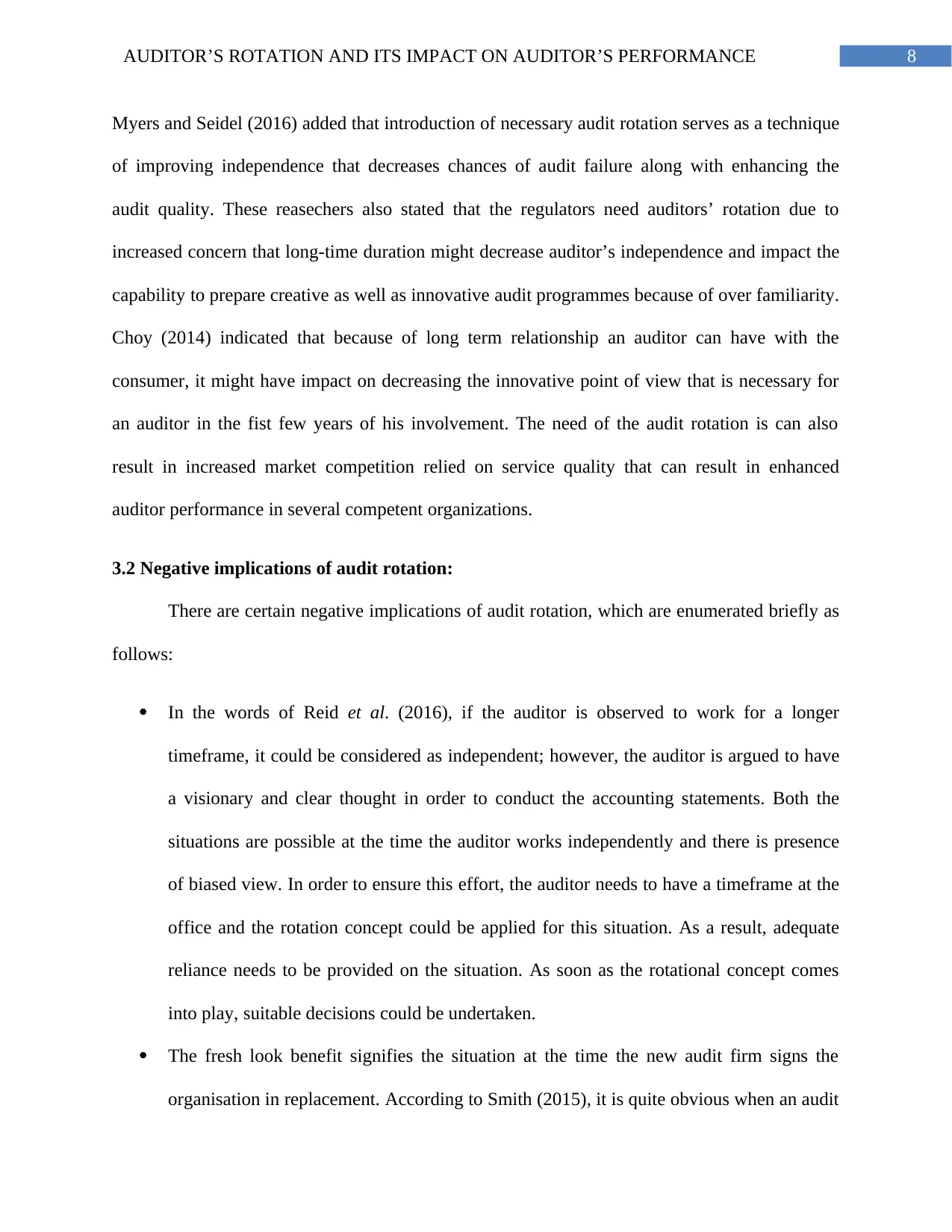
8AUDITOR’S ROTATION AND ITS IMPACT ON AUDITOR’S PERFORMANCE
Myers and Seidel (2016) added that introduction of necessary audit rotation serves as a technique
of improving independence that decreases chances of audit failure along with enhancing the
audit quality. These reasechers also stated that the regulators need auditors’ rotation due to
increased concern that long-time duration might decrease auditor’s independence and impact the
capability to prepare creative as well as innovative audit programmes because of over familiarity.
Choy (2014) indicated that because of long term relationship an auditor can have with the
consumer, it might have impact on decreasing the innovative point of view that is necessary for
an auditor in the fist few years of his involvement. The need of the audit rotation is can also
result in increased market competition relied on service quality that can result in enhanced
auditor performance in several competent organizations.
3.2 Negative implications of audit rotation:
There are certain negative implications of audit rotation, which are enumerated briefly as
follows:
In the words of Reid et al. (2016), if the auditor is observed to work for a longer
timeframe, it could be considered as independent; however, the auditor is argued to have
a visionary and clear thought in order to conduct the accounting statements. Both the
situations are possible at the time the auditor works independently and there is presence
of biased view. In order to ensure this effort, the auditor needs to have a timeframe at the
office and the rotation concept could be applied for this situation. As a result, adequate
reliance needs to be provided on the situation. As soon as the rotational concept comes
into play, suitable decisions could be undertaken.
The fresh look benefit signifies the situation at the time the new audit firm signs the
organisation in replacement. According to Smith (2015), it is quite obvious when an audit
Myers and Seidel (2016) added that introduction of necessary audit rotation serves as a technique
of improving independence that decreases chances of audit failure along with enhancing the
audit quality. These reasechers also stated that the regulators need auditors’ rotation due to
increased concern that long-time duration might decrease auditor’s independence and impact the
capability to prepare creative as well as innovative audit programmes because of over familiarity.
Choy (2014) indicated that because of long term relationship an auditor can have with the
consumer, it might have impact on decreasing the innovative point of view that is necessary for
an auditor in the fist few years of his involvement. The need of the audit rotation is can also
result in increased market competition relied on service quality that can result in enhanced
auditor performance in several competent organizations.
3.2 Negative implications of audit rotation:
There are certain negative implications of audit rotation, which are enumerated briefly as
follows:
In the words of Reid et al. (2016), if the auditor is observed to work for a longer
timeframe, it could be considered as independent; however, the auditor is argued to have
a visionary and clear thought in order to conduct the accounting statements. Both the
situations are possible at the time the auditor works independently and there is presence
of biased view. In order to ensure this effort, the auditor needs to have a timeframe at the
office and the rotation concept could be applied for this situation. As a result, adequate
reliance needs to be provided on the situation. As soon as the rotational concept comes
into play, suitable decisions could be undertaken.
The fresh look benefit signifies the situation at the time the new audit firm signs the
organisation in replacement. According to Smith (2015), it is quite obvious when an audit
⊘ This is a preview!⊘
Do you want full access?
Subscribe today to unlock all pages.

Trusted by 1+ million students worldwide
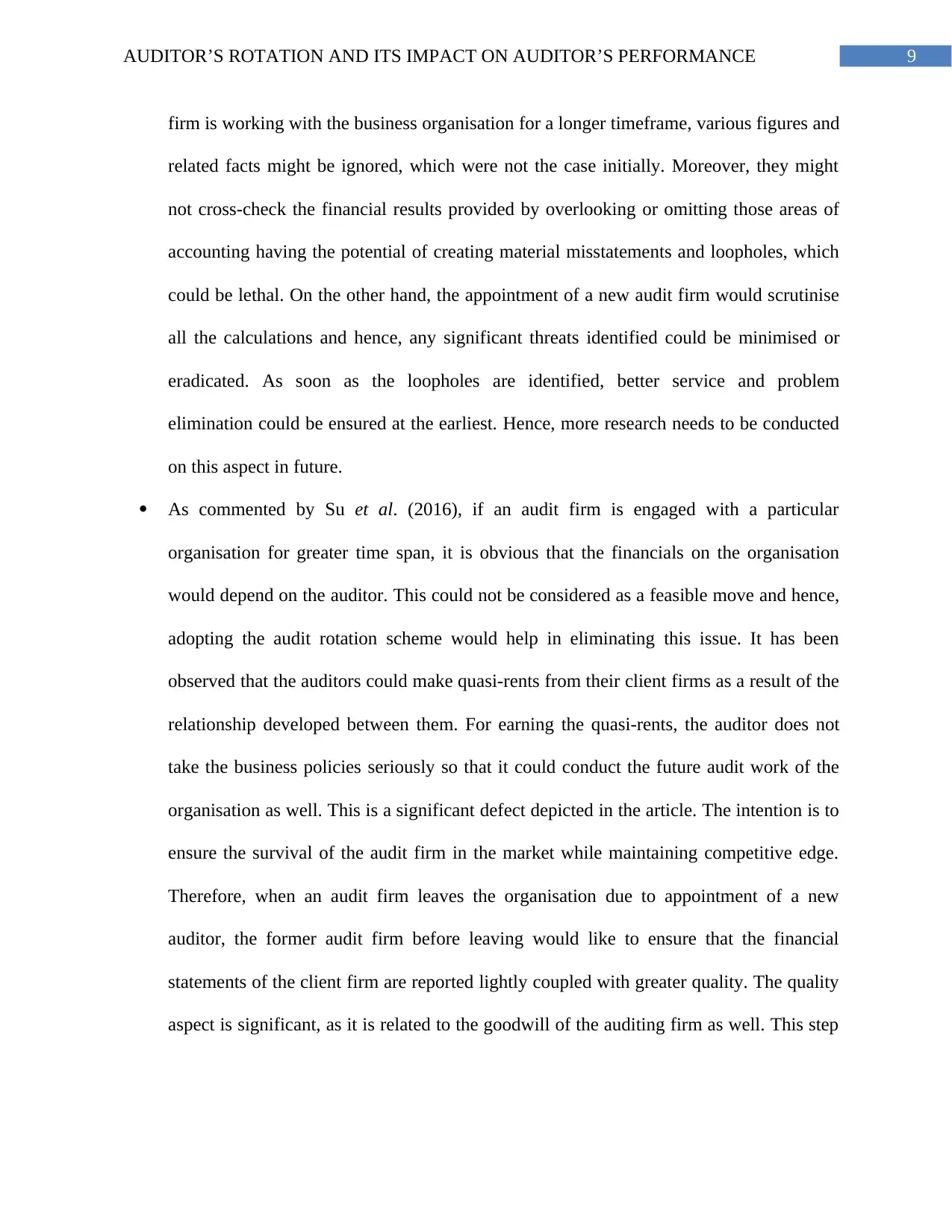
9AUDITOR’S ROTATION AND ITS IMPACT ON AUDITOR’S PERFORMANCE
firm is working with the business organisation for a longer timeframe, various figures and
related facts might be ignored, which were not the case initially. Moreover, they might
not cross-check the financial results provided by overlooking or omitting those areas of
accounting having the potential of creating material misstatements and loopholes, which
could be lethal. On the other hand, the appointment of a new audit firm would scrutinise
all the calculations and hence, any significant threats identified could be minimised or
eradicated. As soon as the loopholes are identified, better service and problem
elimination could be ensured at the earliest. Hence, more research needs to be conducted
on this aspect in future.
As commented by Su et al. (2016), if an audit firm is engaged with a particular
organisation for greater time span, it is obvious that the financials on the organisation
would depend on the auditor. This could not be considered as a feasible move and hence,
adopting the audit rotation scheme would help in eliminating this issue. It has been
observed that the auditors could make quasi-rents from their client firms as a result of the
relationship developed between them. For earning the quasi-rents, the auditor does not
take the business policies seriously so that it could conduct the future audit work of the
organisation as well. This is a significant defect depicted in the article. The intention is to
ensure the survival of the audit firm in the market while maintaining competitive edge.
Therefore, when an audit firm leaves the organisation due to appointment of a new
auditor, the former audit firm before leaving would like to ensure that the financial
statements of the client firm are reported lightly coupled with greater quality. The quality
aspect is significant, as it is related to the goodwill of the auditing firm as well. This step
firm is working with the business organisation for a longer timeframe, various figures and
related facts might be ignored, which were not the case initially. Moreover, they might
not cross-check the financial results provided by overlooking or omitting those areas of
accounting having the potential of creating material misstatements and loopholes, which
could be lethal. On the other hand, the appointment of a new audit firm would scrutinise
all the calculations and hence, any significant threats identified could be minimised or
eradicated. As soon as the loopholes are identified, better service and problem
elimination could be ensured at the earliest. Hence, more research needs to be conducted
on this aspect in future.
As commented by Su et al. (2016), if an audit firm is engaged with a particular
organisation for greater time span, it is obvious that the financials on the organisation
would depend on the auditor. This could not be considered as a feasible move and hence,
adopting the audit rotation scheme would help in eliminating this issue. It has been
observed that the auditors could make quasi-rents from their client firms as a result of the
relationship developed between them. For earning the quasi-rents, the auditor does not
take the business policies seriously so that it could conduct the future audit work of the
organisation as well. This is a significant defect depicted in the article. The intention is to
ensure the survival of the audit firm in the market while maintaining competitive edge.
Therefore, when an audit firm leaves the organisation due to appointment of a new
auditor, the former audit firm before leaving would like to ensure that the financial
statements of the client firm are reported lightly coupled with greater quality. The quality
aspect is significant, as it is related to the goodwill of the auditing firm as well. This step
Paraphrase This Document
Need a fresh take? Get an instant paraphrase of this document with our AI Paraphraser
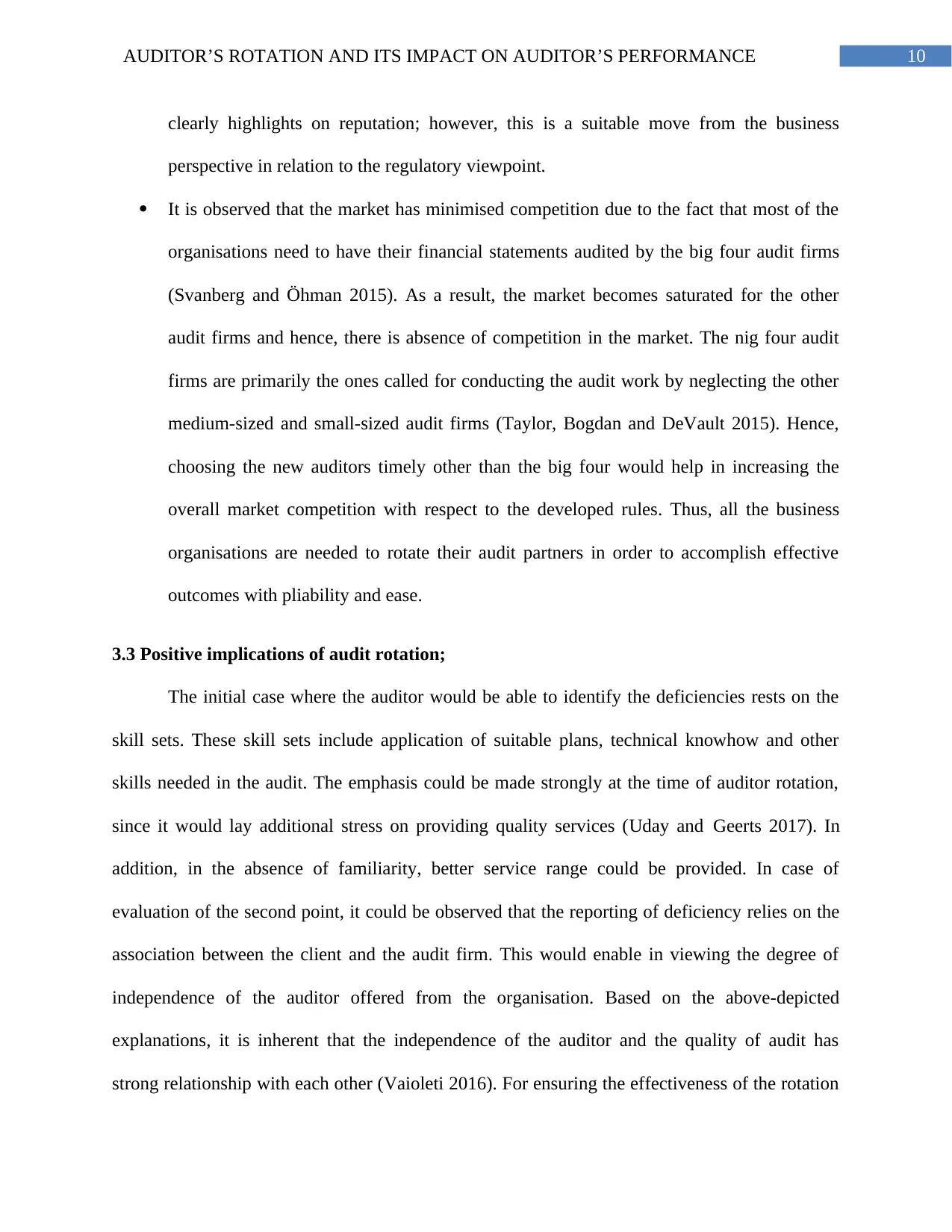
10AUDITOR’S ROTATION AND ITS IMPACT ON AUDITOR’S PERFORMANCE
clearly highlights on reputation; however, this is a suitable move from the business
perspective in relation to the regulatory viewpoint.
It is observed that the market has minimised competition due to the fact that most of the
organisations need to have their financial statements audited by the big four audit firms
(Svanberg and Öhman 2015). As a result, the market becomes saturated for the other
audit firms and hence, there is absence of competition in the market. The nig four audit
firms are primarily the ones called for conducting the audit work by neglecting the other
medium-sized and small-sized audit firms (Taylor, Bogdan and DeVault 2015). Hence,
choosing the new auditors timely other than the big four would help in increasing the
overall market competition with respect to the developed rules. Thus, all the business
organisations are needed to rotate their audit partners in order to accomplish effective
outcomes with pliability and ease.
3.3 Positive implications of audit rotation;
The initial case where the auditor would be able to identify the deficiencies rests on the
skill sets. These skill sets include application of suitable plans, technical knowhow and other
skills needed in the audit. The emphasis could be made strongly at the time of auditor rotation,
since it would lay additional stress on providing quality services (Uday and Geerts 2017). In
addition, in the absence of familiarity, better service range could be provided. In case of
evaluation of the second point, it could be observed that the reporting of deficiency relies on the
association between the client and the audit firm. This would enable in viewing the degree of
independence of the auditor offered from the organisation. Based on the above-depicted
explanations, it is inherent that the independence of the auditor and the quality of audit has
strong relationship with each other (Vaioleti 2016). For ensuring the effectiveness of the rotation
clearly highlights on reputation; however, this is a suitable move from the business
perspective in relation to the regulatory viewpoint.
It is observed that the market has minimised competition due to the fact that most of the
organisations need to have their financial statements audited by the big four audit firms
(Svanberg and Öhman 2015). As a result, the market becomes saturated for the other
audit firms and hence, there is absence of competition in the market. The nig four audit
firms are primarily the ones called for conducting the audit work by neglecting the other
medium-sized and small-sized audit firms (Taylor, Bogdan and DeVault 2015). Hence,
choosing the new auditors timely other than the big four would help in increasing the
overall market competition with respect to the developed rules. Thus, all the business
organisations are needed to rotate their audit partners in order to accomplish effective
outcomes with pliability and ease.
3.3 Positive implications of audit rotation;
The initial case where the auditor would be able to identify the deficiencies rests on the
skill sets. These skill sets include application of suitable plans, technical knowhow and other
skills needed in the audit. The emphasis could be made strongly at the time of auditor rotation,
since it would lay additional stress on providing quality services (Uday and Geerts 2017). In
addition, in the absence of familiarity, better service range could be provided. In case of
evaluation of the second point, it could be observed that the reporting of deficiency relies on the
association between the client and the audit firm. This would enable in viewing the degree of
independence of the auditor offered from the organisation. Based on the above-depicted
explanations, it is inherent that the independence of the auditor and the quality of audit has
strong relationship with each other (Vaioleti 2016). For ensuring the effectiveness of the rotation
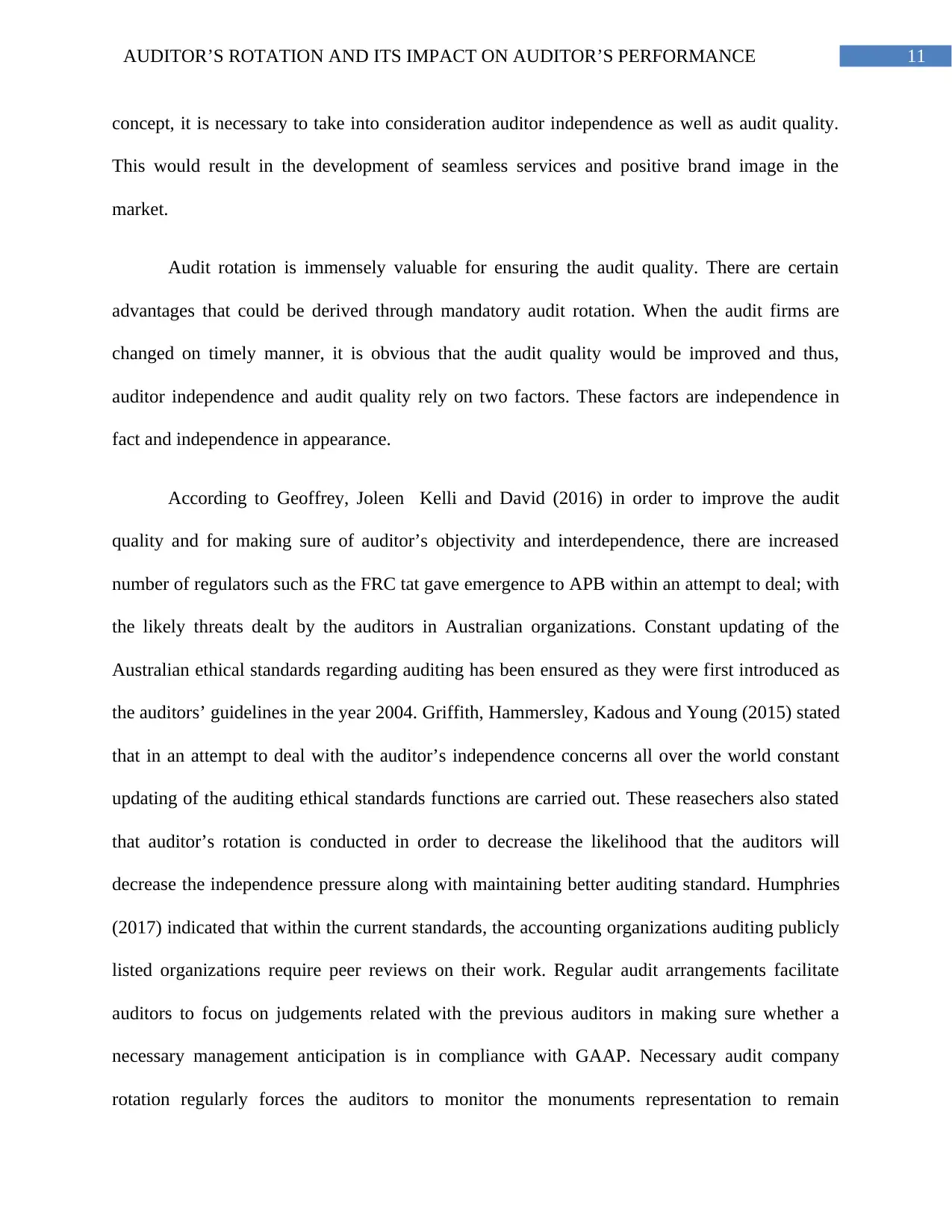
11AUDITOR’S ROTATION AND ITS IMPACT ON AUDITOR’S PERFORMANCE
concept, it is necessary to take into consideration auditor independence as well as audit quality.
This would result in the development of seamless services and positive brand image in the
market.
Audit rotation is immensely valuable for ensuring the audit quality. There are certain
advantages that could be derived through mandatory audit rotation. When the audit firms are
changed on timely manner, it is obvious that the audit quality would be improved and thus,
auditor independence and audit quality rely on two factors. These factors are independence in
fact and independence in appearance.
According to Geoffrey, Joleen Kelli and David (2016) in order to improve the audit
quality and for making sure of auditor’s objectivity and interdependence, there are increased
number of regulators such as the FRC tat gave emergence to APB within an attempt to deal; with
the likely threats dealt by the auditors in Australian organizations. Constant updating of the
Australian ethical standards regarding auditing has been ensured as they were first introduced as
the auditors’ guidelines in the year 2004. Griffith, Hammersley, Kadous and Young (2015) stated
that in an attempt to deal with the auditor’s independence concerns all over the world constant
updating of the auditing ethical standards functions are carried out. These reasechers also stated
that auditor’s rotation is conducted in order to decrease the likelihood that the auditors will
decrease the independence pressure along with maintaining better auditing standard. Humphries
(2017) indicated that within the current standards, the accounting organizations auditing publicly
listed organizations require peer reviews on their work. Regular audit arrangements facilitate
auditors to focus on judgements related with the previous auditors in making sure whether a
necessary management anticipation is in compliance with GAAP. Necessary audit company
rotation regularly forces the auditors to monitor the monuments representation to remain
concept, it is necessary to take into consideration auditor independence as well as audit quality.
This would result in the development of seamless services and positive brand image in the
market.
Audit rotation is immensely valuable for ensuring the audit quality. There are certain
advantages that could be derived through mandatory audit rotation. When the audit firms are
changed on timely manner, it is obvious that the audit quality would be improved and thus,
auditor independence and audit quality rely on two factors. These factors are independence in
fact and independence in appearance.
According to Geoffrey, Joleen Kelli and David (2016) in order to improve the audit
quality and for making sure of auditor’s objectivity and interdependence, there are increased
number of regulators such as the FRC tat gave emergence to APB within an attempt to deal; with
the likely threats dealt by the auditors in Australian organizations. Constant updating of the
Australian ethical standards regarding auditing has been ensured as they were first introduced as
the auditors’ guidelines in the year 2004. Griffith, Hammersley, Kadous and Young (2015) stated
that in an attempt to deal with the auditor’s independence concerns all over the world constant
updating of the auditing ethical standards functions are carried out. These reasechers also stated
that auditor’s rotation is conducted in order to decrease the likelihood that the auditors will
decrease the independence pressure along with maintaining better auditing standard. Humphries
(2017) indicated that within the current standards, the accounting organizations auditing publicly
listed organizations require peer reviews on their work. Regular audit arrangements facilitate
auditors to focus on judgements related with the previous auditors in making sure whether a
necessary management anticipation is in compliance with GAAP. Necessary audit company
rotation regularly forces the auditors to monitor the monuments representation to remain
⊘ This is a preview!⊘
Do you want full access?
Subscribe today to unlock all pages.

Trusted by 1+ million students worldwide
1 out of 24
Related Documents
Your All-in-One AI-Powered Toolkit for Academic Success.
+13062052269
info@desklib.com
Available 24*7 on WhatsApp / Email
![[object Object]](/_next/static/media/star-bottom.7253800d.svg)
Unlock your academic potential
Copyright © 2020–2025 A2Z Services. All Rights Reserved. Developed and managed by ZUCOL.





